Updated May 1
Who’s Left Standing When COVID-19 Crisis Ends?
Nekesa Moody Named Editor of Hollywood Reporter
Boxing Writer Willis Laid Off After 23 Years
Editor Lays Himself Off to Save Others
COVID-19 Has Black Papers Fighting to Stay Alive
Despite Early Deadlines, Comics Address Pandemic
How Small-Town Media Can Be More Inclusive
Editors Group Chooses Best in Journalism
Passings: Willie Dixon, Luis Echegoyen, Nick Kotz, Laura Beth Randolph-Lancaster, Eugene Kane coda
Short Takes
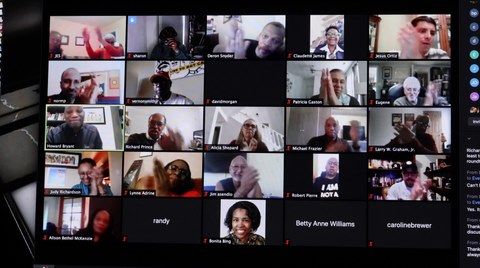
Who’s Left Standing When COVID-19 Crisis Ends?
“People are just really, really concerned about what we’re coming back into,” says Howard Bryant of ESPN.com, and author of a new book on anti-blackness. He was speaking of the eventual end of the COVID-19 crisis, and how it will have affected the sports world.
How many black players and black sports journalists will still have jobs?
Will the rich get richer and the less rich be kicked to the curb? Who will be left standing?
Those were some of the questions on the table as the Journal-isms Roundtable met via Zoom on Sunday with Bryant and other sharp-minded journalists, mostly of color, and joining from Boston; Chicago; St. Croix, V.I.; New York; Lawrence, Kan.; Savannah, Ga.; Rochester, N.Y.; San Luis Obispo, Calif.; Houston; and Washington, D.C.
When the 32 who participated concluded, as many as 20 story ideas had surfaced, some said, and even the non-sports-minded emerged with a clearer understanding of the stakes for journalism, society and sports.
You can watch video of the discussion at < https://bit.ly/35dzKcN >
Why is what happens with sports important? one journalist asked. Bryant laid out the stats: The National Football League is a $15-billion-a-year business; Major League Baseball, $20 billion; National Basketball Association, $10 billion; billions more for college basketball and [$933 million] just from the NCAA’s Final Four.
That doesn’t include all of the satellite businesses — the shops and restaurants — that take their cues and livelihoods from nearby stadiums, as Michael Frazier, a former Newsday journalist and Mike Bloomberg campaign spokesman, pointed out.
The sports world’s reach is also political. The teams have political action committees. Earlier this month, President Trump appointed a group of prominent sports executives and team owners to serve as advisers for restarting the U.S economy. No players were among them.
Will it be the black players who are pushed to the field to make money for the owners, even though it might not be safe?
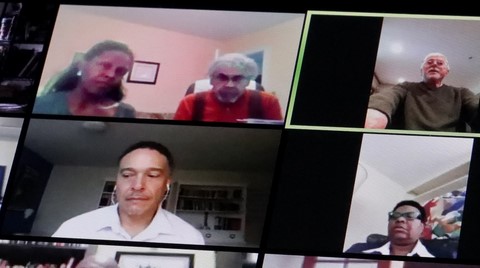
“I think we’re headed toward what could be a really thorny, difficult debate going on about sports and with coming back,” said Randal Archibold, sports editor of The New York Times.
“As with so much with this disease, it’s the testing. This country is so woefully behind and so nowhere near where it needs to be to have any real reopening. I just wonder whether that’s going to collide head on with . . . this push for ‘let’s get on with it.’ “
Added Bryant, “How do you play this game, how do you play football with no contact? I mean, at some point — the two ideas are incongruous. You have to have more information than you have right now to get on with it unless you’re willing to sacrifice people. And that’s what’s going to happen, I think.”
The NBA could reopen some team practice facilities as soon as May 8, the Associated Press reported Monday, saying that the NBA wanted to be sure that player-training options would be safe and controlled.
As for journalists, “People from all beats are being laid off throughout the country,” noted Jesus Ortiz, veteran sports columnist now based in Houston.
“My biggest concern is what sports journalism looks like after this,” added Larry R. Graham Jr., who chairs the diversity committee of Associated Press Sports Editors.
Only 22.8 percent of news organizations last year responded to the annual diversity survey of the American Society of News Editors, now the News Leaders Association.
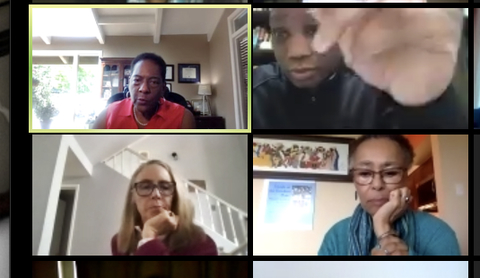
“When it comes to APSE, you don’t get a lot of participation. Those sports editors tell you, ‘hey, this is how many people of color I have on staff. Last time those numbers were reported, it was 85 of those editors were white, what, [77] percent of the assistant sports editors were white, [80] percent of columnists. . . .
“When we come back from this, we won’t be able to see who was laid off because we didn’t have accurate numbers to begin with; those people aren’t going to want to share if those numbers got worse. We’ll have no comparison.”
“That was a big issue anyway,” said Bryant. “When I look on TV, especially when it comes to black journalism, I feel incredibly pessimistic and angry in a lot of different ways because you see . . . that there’s movement and opportunity for a lot of different demographics but not black men. . . . You see black males being on the air but they’re having ex-players; they’re not journalists.
“So what ends up happening is, you look at the slotting when you watch television, you see white woman host, black male ex-player, black male ex-player or white ex-coach, and then white reporter. . . .”
That, in turn, affects the coverage. Bryant said, “I know on the sports side I think there’s been a fair amount of timidity in terms of actually talking about the effects of this because we’re looking at a couple of different elements here. And one of those elements is the ‘let’s get on with it.’
“And I am very concerned more than anything else that’s taken place over the last month, about this idea that, ‘OK, it’s time, let’s go,’ and that sports is going to be the leader in that.” Bryant asked at another point, “Do we promote sports or do we cover them?”
When the athletes do return, how much access will the reporters have to the players? “I was president of the BBWAA [Baseball Writers’ Association of America] one year,” Ortiz said, “and you see access questions all year in a normal situation, and now with this, I could see them saying, ‘Hey, you can only have Zoom interviews after games.’ That’s what I’m waiting to see, and that’ll change the coverage for everybody.”
Bryant added, “Now this is going to be a very convenient reason to say, ‘Well, now we can’t go back to the way it was, cause there are too many guys . . . especially in places like Fenway Park, where the clubhouses are tiny, or places like Yankee Stadium, where they’re a little bit bigger now with the new stadium, or Chicago with the Cubs, where there are — where the room is just really, really tight. . . .”
All the more reason for sports reporters to consider themselves simply reporters who can cover topics across subject areas and over platforms, Bryant and Ortiz said.
Moreover, the pipeline to reporting jobs will be interrupted if high school sports coverage — where many sportswriters got their start — is curtailed because schools are closed, Wanda S. Lloyd, retired editor of the Montgomery (Ala.) Advertiser, said.
A constant theme was that players’ voices were often missing. As Bryant wrote in his 2018 book “The Heritage: Black Athletes, A Divided America and the Politics of Patriotism,” and William C. Rhoden reported in his 2006 book “Forty Million Dollar Slaves: The Rise, Fall, and Redemption of the Black Athlete,” black athletes don’t have the power commensurate with their salaries. They are most often not in the room when key decisions are made.
“I think it’s even difficult for the people in the room, ’cause it’s not just about having somebody black in the room. Does that black person in the room have the power to speak up?
“Or is it, ‘If I speak up, I’m going to be the one, I’m not going to be in the room any longer. I’m here just to . . . make them look good’. How many times are you in a position where you’ve got the power to actually speak up; you’ve got the security to stand up. It just doesn’t happen very often [that] you have that combination.”
The question extends to college sports. How will it look if schools bring back college athletes while the rest of the school is closed? The journalists said that would expose the school’s exploitation of these unpaid athletes as de facto employees.
In addition, “Some of those conferences, particularly at black colleges, are going to go away . . .,” predicted Robert Pierre, a former Washington Post reporter and editor now in public relations. “Some of those programs, they live from check to check and they can’t survive it.”
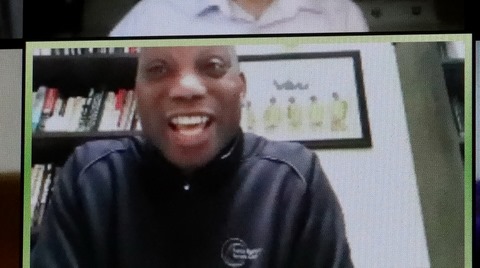
That led Bryant into a discussion of his new book, “Full Dissidence: Notes From an Uneven Playing Field.”
“I started thinking about the level of anti-blackness in this country. I started thinking about the athletes and how much anti-blackness existed in this industry, where supposedly you’re bringing people together but yet the black players risk everything for even having an opinion,” he said.
“And so, are they really bringing people together or are they simply really, really rich but don’t have a real say. . . .
“I started to think about that, even from journalism. The number of black writers who would say things to me like, ‘I’m not a black reporter, I’m just a reporter who happens to be black.’
“And I’m thinking, I can’t think of another industry where people talk about themselves like that. . . . You never heard Oscar Wilde say, ‘Well, I’m not an Irish writer, I’m just a writer who happens to be Irish.’ Oh, no, they infuse their Irishness into their writing, and they brought us along with them. And for us, we’re constantly having to make that negotiation.”
However, Bryant said, he did feel most optimistic about the recognition by some “that they have choices. . . . In our business, when you’re not in the mainstream, you have to feel that you have to follow along, . . . you have to ride the current, and I think people are recognizing that they don’t . . . and we’re starting to see more writers have more opinions, and you’re seeing it on the black side, you’re seeing it on the women’s side in all kind of different areas. . . . “
Judy Richardson was listening.
A member of the Legacy Committee of the 1960s’ Student Nonviolent Coordinating Committee, she began the meeting by updating attendees on SNCC’s 60th anniversary commemoration, which was abbreviated in March because of the pandemic. The full event will now be held in the first week of June 2021.
“I’m not into sports. Never have been,” she said at the meeting’s close. “I don’t even look at the Olympics, OK? This has been a fascinating conversation, and it goes beyond anything that has to do with sports.” Attendees countered what she had heard about succeeding generations losing some of their racial consciousness.
It gave her “something that you can hold on to [amid] all the craziness and the idiot in the White House.”
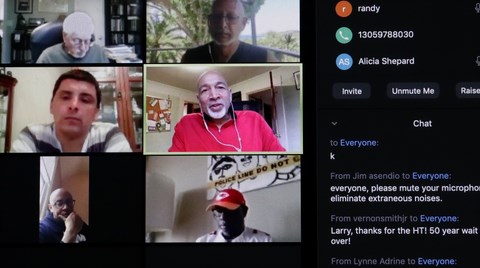
- Akintunde Ahmad, Columbia Journalism Review: The sports press without the sports (April 15)
- Trevon Logan, The Conversation: Top football recruits bring in big money for colleges – COVID-19 could threaten revenue
- The Shadow League: Coronavirus Attacks Sports: College Athletes Get To Run It Back in 2021 (March 13)
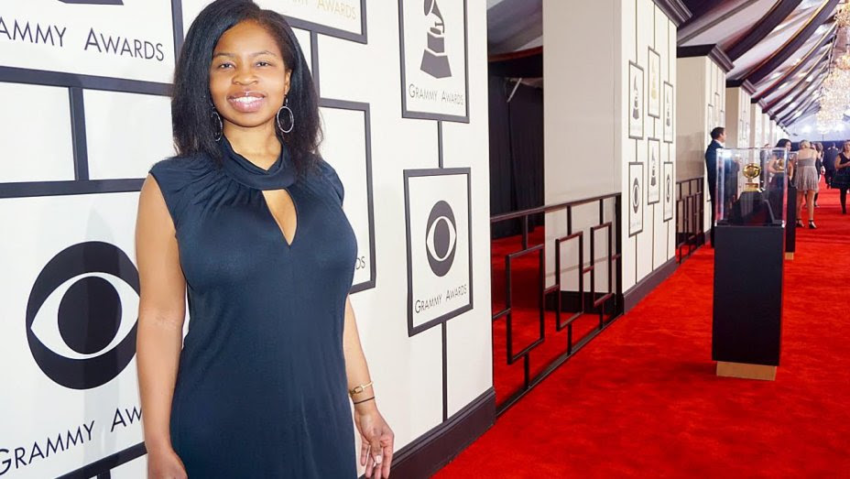
Nekesa Moody Named Editor of Hollywood Reporter
“Nekesa Mumbi Moody, who has served as global entertainment and lifestyles editor at The Associated Press since 2012, has been named to the top editorial role at The Hollywood Reporter,” the entertainment industry publication announced Thursday. “Moody will relocate from New York to Los Angeles and starts in the role on June 15.
” ‘The Hollywood Reporter has consistently produced some of the most important, informative and revealing stories about the entertainment industry. I’m thrilled to join and look forward to building on the incredible work of its journalists as Hollywood finds itself facing new challenges amid historic change,’ said Moody.
“At The Associated Press, Moody oversaw a team of 40 journalists and directed multiformat entertainment coverage for the wire service, breaking news and producing exclusive content for newspapers, online portals and broadcasters.
” ‘Nekesa is an incredibly smart, well-respected journalist and seasoned leader who can confidently shape the next chapter of this venerable brand and we are proud to welcome her to The Hollywood Reporter,’ said Deanna Brown, president of Billboard-The Hollywood Reporter Media Group. . . .”
- Maxwell Tani and Lachlan Cartwright, Daily Beast: The Hollywood Reporter Announces New Top Boss Amid Exec-Level Turmoil
Writer George Willis, right, is interviewed in 2015 by Derrel “Jazz” Johnson, New York sports and entertainment journalist, about an upcoming bout between Floyd Mayweather and Manny Pacquiao. Mayweather won the contest by unanimous decision. (Credit: YouTube)
Boxing Writer Willis Laid Off After 23 Years
“Today was my last day at the New York Post,” George Willis, one of the nation’s leading boxing writers, told his Facebook followers Wednesday. “After 23 years as a Sports Columnist, I was informed that my position had been ‘eliminated.’
“To all the friends, colleagues, players, coaches, media, pr and other personalities I’ve met along the way, my family and I would like [to] thank you for being part of what has been a truly great run. I eagerly await what God has in store for my next chapter. Stay safe. #FreeAgent.”
Willis is the author of 2013’s “The Bite Fight: Tyson, Holyfield and the Night That Changed Boxing Forever,” about the 1997 Las Vegas match in which Mike Tyson twice sunk his teeth into Evander Holyfield’s ears. Tyson was then disqualified.
A native of Las Cruces, N.M., Willis also worked at The New York Times, Newsday and the Commercial Appeal in Memphis.
Editor Lays Himself Off to Save Others
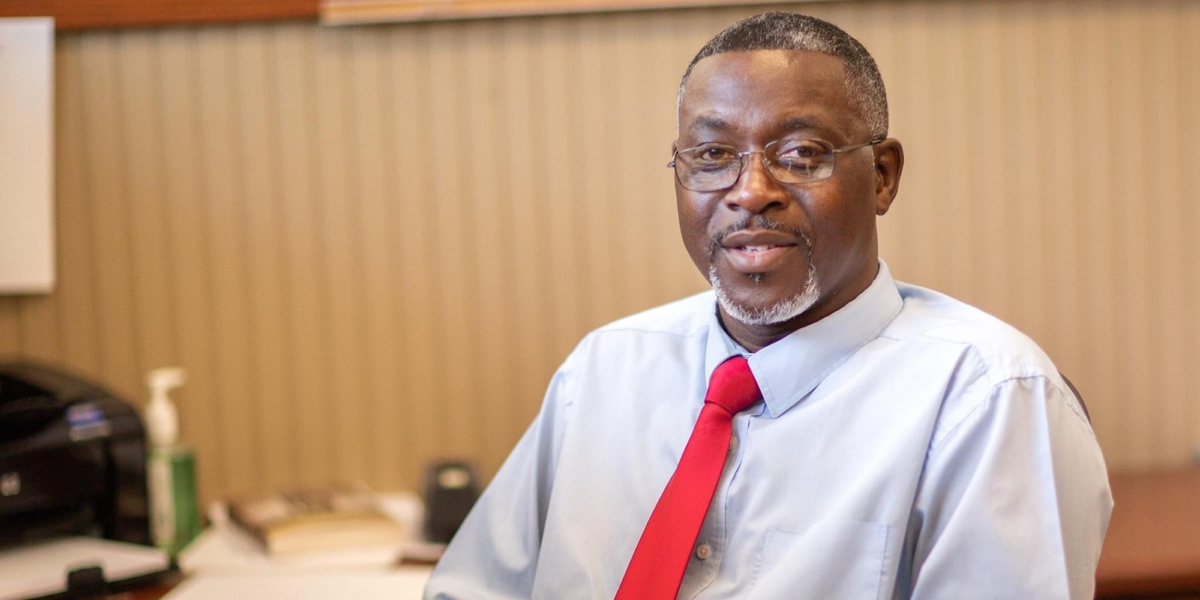 “In an era when media companies are slashing newsrooms to stay afloat, one editor just gave up his job so that his reporters wouldn’t lose theirs,” Aaron Short reported April 20 for Business Insider.
“In an era when media companies are slashing newsrooms to stay afloat, one editor just gave up his job so that his reporters wouldn’t lose theirs,” Aaron Short reported April 20 for Business Insider.
“Two weeks ago Anthony Cook (pictured), executive editor of Alabama-based Consolidated Publishing, told his staff that he was voluntarily stepping down from his position and eliminating the editorial pages in the company’s flagship paper, The Anniston Star.
” ‘In times of crisis, we have to keep our priorities straight, and, frankly, the news is more important than I am,’ Cook, 49, wrote in his final column for the Star on April 10. . . . “
Frances Murphy Draper, publisher of the Afro-American newspaper, appeals to readers for assistance in this April 14 video. (Credit: YouTube)
COVID-19 Has Black Papers Fighting to Stay Alive
“Publishers of Black-owned community newspapers, including Janis Ware of the Atlanta Voice, Cheryl Smith of Texas Metro News, Chris Bennett of the Seattle Medium, Denise Rolark Barnes of the Washington Informer, and Brenda Andrews of the New Journal & Guide in Virginia, are desperately trying to avoid shuttering operations,” Stacy M. Brown of the National Newspaper Publishers Association wrote Sunday.
“With major companies like Ruth Chris Steakhouse and Pot Belly Sandwiches swooping in and hijacking stimulus money aimed at small businesses, the Black Press — and community-based publishing in general — has been largely left out of the $350 billion stimulus and Paycheck Protection Program packages.
“To make matters worse, there are no guarantees that a second package, specifically focused on small business, will benefit Black publishers or other businesses owned by people of color. . . .”
Meanwhile, the Afro-American Newspapers of Baltimore and Washington joined the Washington Informer in asking readers to help them afloat.
“We’ve furloughed nearly 25 percent of our employees, as we fight to stay in business,” Afro-American Publisher Frances Murphy Draper wrote April 16. “And, due to government restrictions and our concern for the safety of our distributors, we’ve suspended our street sales* . . .
“But there is some good news! We are among a handful of African-American publications in the country who are participating in a nationwide 501c3 COVID-19 local news fund hosted by the Local Media Association. The fund is designed to enable support for independent publishers and family-owned publications, like the AFRO. . . .”
In Norfolk, Va., the New Journal & Guide announced April 9 that it was suspending print publication, hoping to resume on or before June 4.
- Joshua Benton, Nieman Lab: In a cosmic irony, it’s the big chain-owned newspapers that can’t seem to get any help from the government
- Paul Farhi, Washington Post: Axios returns coronavirus bailout loan as news organizations grapple with the ethics of taking government funds
- Kristen Hare and Ren LaForme, Poynter Institute: Here’s what we know so far about the layoffs at Gannett
- Keith J. Kelly, New York Post: Gannett layoffs continue as photographers complain they lack coronavirus protection
- Veronica Villafañe, Media Moves: Layoffs and news programming cuts underway at Univision as part of restructuring
Despite Early Deadlines, Comics Address Pandemic
“Unlike internet cartoonists, who can respond immediately to current events, creators of daily newspaper strips work about two weeks in advance, sometimes longer,” Gavin Edwards wrote Monday for The New York Times.
“And there can be many motivations for artists to exercise caution, from not knowing how to adjust a lighthearted formula to not wanting to trivialize a widespread tragedy.”
In “recent weeks, when a handful of daily newspaper cartoonists began running strips inspired by the coronavirus, it felt unusually vibrant and immediate; we spoke with six of them. . . .”
They included two of color, Lalo Alcaraz and Ray Billingsley.
“I’m about characterization and continuity,” Billingsley, creator of the ‘Curtis” strip, said in the story. “I hope that ‘Curtis’ is an emotional experience.”
Edwards continued, ” ‘This strip about Anne Frank was inspired by a friend of Billingsley’s who complained about being unable to go to the movies. ‘As Americans, we’re very much spoiled,’ Billingsley commented. ‘People tend to forget the past, and it wasn’t even that far past.’ ”

” ‘My strip is very news-oriented and political, so there was no way that I was not going to comment on the quarantine,’ said Lalo Alcaraz, creator of ‘La Cucaracha.’ ‘My strip is about what the Latino community is going through — all the angles.’ . . .
“Alcaraz has found it easier to write strips about coronavirus’s societal impact; jokes about actual illness have felt inappropriate to him. He is used to a steady drumbeat of hate mail, even on topics that he doesn’t find controversial, such as praise for farmworkers, but he reported that he’s gotten almost no negative feedback lately: ‘My usual haters, hopefully they’re not sick.’ . . .”https://www.ifj.org/media-centre/news/detail/category/press-releases/article/india-simplicity-founder-detained-for-criticism-of-governments-covid-19-response.html
- Balancing Act: African Broadcasting in a Time of COVID-19 – Reports From the Front Line in Ghana, Kenya and Rwanda
- Nick Charles, NBC News: Black-owned businesses fear federal relief may not be enough
- Nick Charles, NBC News: Black female inmates and COVID-19: Medically compromised, vulnerable and neglected
- Suzanne Gamboa, NBC News: Coronavirus package falls short for lenders to Latino, minority businesses
- Suzanne Gamboa, NBC News: Few Hispanic business owners got coronavirus relief loans, Latino survey finds
- Tim Giago, indianz.com: Will Things Ever Be the Same?
- International Federation of Journalists: India: SimpliCity founder detained for criticism of government’s Covid-19 response
- International Press Institute: Growing press freedom violations in Africa amid COVID-19
- Joyce Jiang, refinery29.com: Born In 2002: What It’s Like To Be A Chinese-American High School Senior During Coronavirus (April 17)
- François-Michel Le Tourneau and William Milliken, The Conversation: Covid-19, isolated indigenous peoples and the history of the Amazon (April 21)
- Adam A. Marshall and Gunita Singh, Reporters Committee for Freedom of the Press: Journalists’ guide to HIPAA during the COVID-19 health crisis
- Ben Poston, Tony Barboza, Alejandra Reyes-Velarde, Los Angeles Times: Younger blacks and Latinos are dying of COVID-19 at higher rates in California
- Reporters Without Borders: Covid-19 in Africa: RSF joins a coalition of civil society organizations to demand the release of imprisoned journalists on the continent (April 6, April 7)
- Sarah Ruiz-Grossman, HuffPost: Here’s What It’s Like To Be Undocumented During The Coronavirus Crisis (April 23)
- Melissa Sanchez, ProPublica Illinois: What Happens When the Workers Who Make Hand Soap Get COVID-19? They Protest.
- Sandra Sanchez, Columbia Journalism Review: Year of Fear, Chapter 12: COVID-19 has changed how we report stories on the border
- Sunny Shin, ozy.com: The Forgotten Victims of the Pandemic: The Deaf Community
- Sarafina Wright, Washington Informer: For Smaller HBCUs, Coronavirus Could Be Fatal Blow (April 22)
Despite the lack of concern some African Americans and Latinos feel from local news media covering small-town Chambersburg, Pa., Franklin County, in which the borough sits, celebrates its role in the Underground Railroad. (Credit: Franklin County Visitors Bureau/ YouTube)
How Small-Town Media Can Be More Inclusive
“In our November 2019 piece, we argued that local news narratives too often marginalize the voices of people who are ‘socially distant, but geographically near’ the journalists who cover them,” Letrell Deshan Crittenden and Andrea Wenzel reported for the Tow Center for Digital Journalism at Columbia’s Graduate School of Journalism.
Now Crittenden and Wenzel have gone to Chambersburg, Pa., “a largely rural, heavily conservative part of a swing state,” with a reporter from public radio’s WHYY in Philadelphia “ahead of the 2020 election to better understand the needs and concerns of residents of color within this rural location.”
Part of their report, summarized Tuesday in Columbia Journalism Review, found that “members of the African American and Latinx communities suggested that certain reporters needed to be trained to specifically deal with issues within their communities, and provide reporting that showed a much more expansive picture of their respective communities than has traditionally been offered.
“One African American focus group member argued that, given the legacy of poor reporting and invisibility of communities of color, reporters who cover these marginalized populations should see themselves as more than reporters. They should function as advocates for marginalized voices within the community.
” ‘Speak up. If you go to the Chamber of Commerce . . . and they’re talking about the Third Ward, because that’s supposed to be a disgrace to the community, and you know something about the [Third Ward] because you’re covering (it) as well at this particular meeting, you need to speak up and not let that negativity fester.’
“For the Latinx community, more representation wasn’t enough. The community needed to offer more . . . in Spanish to allow the Latinx community to more fully participate as citizens. This should include, participants said, some sort of news coverage focused on the Latinx community, and provide stories in both English and Spanish.
“Members of the focus group concluded it was necessary to have stories about the Latinx community in English and Spanish, if for no other reason than to provide positive stories about the Latinx community to the larger population. “ ‘This has to be more directed toward the (non-Latinx community), so that they get to know us and see that we’re not all that they say. That we’re people that have come because we need work and come in search of a better future,’ one Latinx participant said. . . .”
- Jenny Choi, medium.com: Journalism Funders: Ways to Uphold Your Diversity and Inclusivity Values During COVID-19 (April 16)
- Saira Kanwal, The Runner, Kwantlen Polytechnic University, British Columbia, Canada: KPU’s All White Journalism Faculty Needs to Diversify
- Michael Kilian, Cynthia Benjamin and Len LaCara, Democrat and Chronicle, Rochester, N.Y.: How the Rochester Democrat and Chronicle forged relationships with communities of color
- Felice Leon, The Root: They Need Us: MSNBC’s Trymaine Lee on Black Journalists and Holding America to Its Ideals
- Lena Mitchell, Daily Journal, Tupelo, Miss.: Diversity of opinion important on op-ed pages
- National Press Club Journalism Institute: Covering Coronavirus: How to be an antiracist (May 4 webinar)
- Poynter Institute: Make Diversity a Priority During the Pandemic (May 6 webinar)
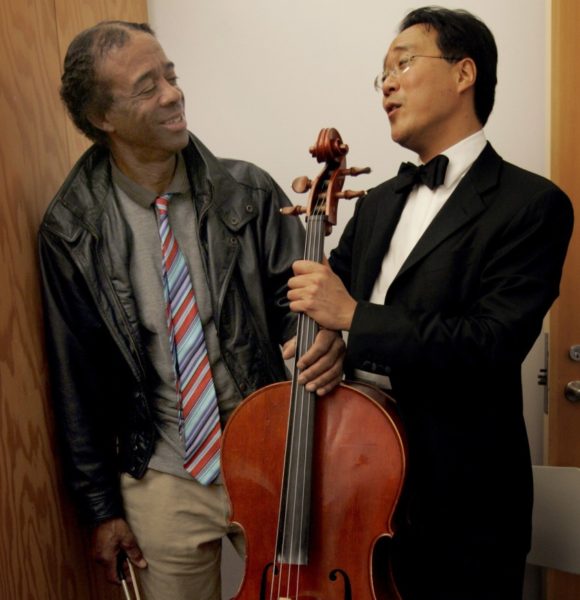
In a Sept. 15 column, the Los Angeles Times’ Steve Lopez revisited his friendship with Nathaniel Ayers, left, the talented musician diagnosed with a severe mental illness who ended up homeless. Shown here with Yo-Yo Ma, Ayers was the subject of Lopez’s best-selling book “The Soloist” and the resulting movie. “Almost 15 years later, Nathaniel lives in a locked mental rehab facility, and the rest of us live at the center of an epic collapse of care and a failure of leadership,” Lopez wrote. (Credit: Francine Orr/Los Angeles Times)
Editors Group Chooses Best in Journalism
The New York Times’ “1619 Project,” columnist Steve Lopez’s work on the L.A. homelessness crisis for the Los Angeles Times, and ProPublica’s and the Chicago Tribune’s revelations that “children, many with special needs, are being locked away in isolation, often in violation of state law” are among the News Leaders Association’s award winners for “distinguished writing, digital storytelling and photography,” the organization announced on Monday.
The News Leaders Association is the product of a merger of the American Society of News Editors and Associated Press Managing Editors.
“The 1619 Project [PDF] is an ongoing initiative from The New York Times Magazine that began in August 2019, the 400th anniversary of the beginning of American slavery,” the Times has explained. “It aims to reframe the country’s history by placing the consequences of slavery and the contributions of black Americans at the very center of our national narrative.”
The project won the NLA’s Dori J. Maynard Award for Justice in Journalism.
“The Quiet Rooms” was a collaborative partnership from ProPublica Illinois and the Chicago Tribune that “exposed alarming and outrageous actions inside Illinois schools and prompted significant results.”
The series, by Jennifer Smith Richards, Jodi S. Cohen and Lakeidra Chavis, won the Frank A. Blethen Award for Local Accountability Reporting, large.
On Lopez’s work on the homeless [PDF], judges said, “Through his stories, we see theirs – that they are people, with full lives and families that love them, and ended up in situations beyond what they imagined. . . .” Lopez and the Times won the Mike Royko Award for commentary and column writing.
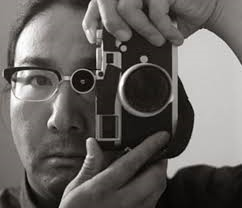 Other winners included Newsday, for “Long Island Divided” [PDF]. Judges said its “ambitious 3-year investigation uncovers discriminatory practices by the real estate industry by deploying undercover testers.” Another winner was “Code Red: Baltimore’s Climate Divide,” [PDF], a multimedia collaboration among Maryland news organizations that “used temperature sensors and other data to investigate the impacts of climate change on the city’s underserved neighborhoods.”
Other winners included Newsday, for “Long Island Divided” [PDF]. Judges said its “ambitious 3-year investigation uncovers discriminatory practices by the real estate industry by deploying undercover testers.” Another winner was “Code Red: Baltimore’s Climate Divide,” [PDF], a multimedia collaboration among Maryland news organizations that “used temperature sensors and other data to investigate the impacts of climate change on the city’s underserved neighborhoods.”
In addition, The Post and Courier in Charleston, S.C., “provided a haunting, detailed report on conditions that led to the deadliest prison riot in 25 years at a South Carolina facility, leaving seven people dead,” winning the First Amendment Award, and Richard Tsong-Taatarii (pictured) of the Star Tribune in Minneapolis won the Visual Journalism Award.
“His laugh, his spirit and his passion for storytelling are some of the dearest memories our ABC13 family will cherish forever,” Houston’s KTRK-TV said of Willie Dixon. (video)
Passings
- “We are mourning the passing of Willie Dixon, a veteran photojournalist who worked for 13 years at ABC13,” Houston’s KTRK-TV reported Monday. “Dixon died unexpectedly Saturday night. He was 52. . . . Willie’s face may not have been familiar to ABC13 viewers, but the video he captured was Houston’s window to the world and some of the most compelling moments in recent history passed through his lens. . . .” Competing stations also prepared tributes.
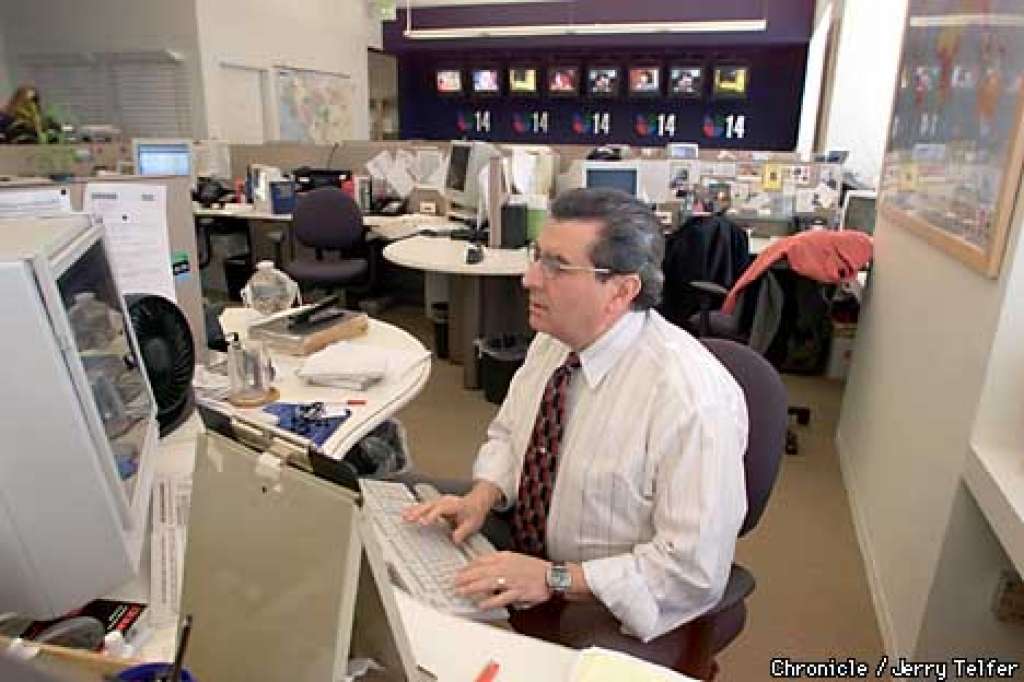 “Luis Echegoyen (pictured, by Michael Maloney, San Francisco Chronicle) the face of Spanish-language news in the San Francisco Bay Area for over 30 years, passed away on Monday, April 6, following a stroke and years of failing health,” Veronica Villafañe reported April 10 for her Media Moves site. “He was 81. A TV personality with a booming voice and a dramatic flair, Luis, who had a fruitful 50-year career in broadcasting, retired as anchor of KDTV Univision 14 in 2006. But he didn’t leave the spotlight. He would go on to do freelance work and briefly hosted his own show ‘Aquí con Luis Echegoyen’ at the Bay Area’s Estrella TV affiliate. . . .”
“Luis Echegoyen (pictured, by Michael Maloney, San Francisco Chronicle) the face of Spanish-language news in the San Francisco Bay Area for over 30 years, passed away on Monday, April 6, following a stroke and years of failing health,” Veronica Villafañe reported April 10 for her Media Moves site. “He was 81. A TV personality with a booming voice and a dramatic flair, Luis, who had a fruitful 50-year career in broadcasting, retired as anchor of KDTV Univision 14 in 2006. But he didn’t leave the spotlight. He would go on to do freelance work and briefly hosted his own show ‘Aquí con Luis Echegoyen’ at the Bay Area’s Estrella TV affiliate. . . .”
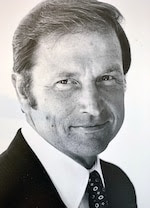 “Nick Kotz (pictured in 1979), who won a Pultizer Prize in 1968 for exposing unsafe and unsanitary conditions in the nation’s meatpacking plants and who later became a Washington Post reporter and the author of books investigating hunger, civil rights and military contracting, died April 26 at his home near Broad Run, Va.,” Matt Schudel reported Wednesday for the Washington Post. “He was 87.” Kotz was last in this column in 2017, when he recalled the Metro Seven case at the Washington Post in 1972, in which seven black Metro reporters filed a discrimination complaint against the newspaper. “I asked reporters on the national staff to have an informal dinner meeting after work at a nearby restaurant to talk about the issue and the need for us to take a stand,” Kotz wrote Journal-isms. “About 8 to 10 of us met. But before we did anything more than talk, [Executive Editor Benjamin C.] Bradlee heard about the dinner, and let me and others know of his displeasure that we were meddling in something that was none of our business. . . .”
“Nick Kotz (pictured in 1979), who won a Pultizer Prize in 1968 for exposing unsafe and unsanitary conditions in the nation’s meatpacking plants and who later became a Washington Post reporter and the author of books investigating hunger, civil rights and military contracting, died April 26 at his home near Broad Run, Va.,” Matt Schudel reported Wednesday for the Washington Post. “He was 87.” Kotz was last in this column in 2017, when he recalled the Metro Seven case at the Washington Post in 1972, in which seven black Metro reporters filed a discrimination complaint against the newspaper. “I asked reporters on the national staff to have an informal dinner meeting after work at a nearby restaurant to talk about the issue and the need for us to take a stand,” Kotz wrote Journal-isms. “About 8 to 10 of us met. But before we did anything more than talk, [Executive Editor Benjamin C.] Bradlee heard about the dinner, and let me and others know of his displeasure that we were meddling in something that was none of our business. . . .”
 Laura Beth Randolph-Lancaster (pictured), a former senior editor at Ebony magazine who created and authored its “Sister Speak” column, died at 62 on March 28 from heart failure. She co-authored several books with Patti LaBelle, including “Don’t Block the Blessings” and “Patti’s Pearls.”
Laura Beth Randolph-Lancaster (pictured), a former senior editor at Ebony magazine who created and authored its “Sister Speak” column, died at 62 on March 28 from heart failure. She co-authored several books with Patti LaBelle, including “Don’t Block the Blessings” and “Patti’s Pearls.”
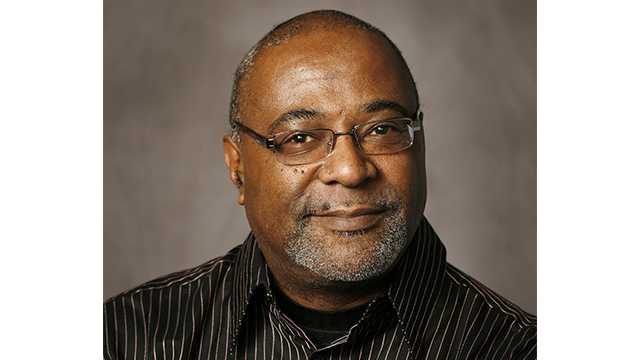 A coda to the tributes to Eugene Kane (pictured), longtime columnist at the Milwaukee Journal Sentinel who was found dead April 16 at 63. Mikel Kwaku Oshi Holt wrote Friday for the Milwaukee Community Journal, “there are only three ‘Old School Black Journalists’ left in the entire state of Wisconsin — Thomas Mitchell, editor of the Community Journal; James Causey, a columnist with the Milwaukee Journal Sentinel; and myself, the writer of the column you’re reading — and the elder spokesman. . . . ‘Old School Black journalists’ distinguish ourselves from mainstream contemporary journalists by the fact we offer another perspective, a view from the ‘field Negroes,’ whose voices have been muted by design. . . .”
A coda to the tributes to Eugene Kane (pictured), longtime columnist at the Milwaukee Journal Sentinel who was found dead April 16 at 63. Mikel Kwaku Oshi Holt wrote Friday for the Milwaukee Community Journal, “there are only three ‘Old School Black Journalists’ left in the entire state of Wisconsin — Thomas Mitchell, editor of the Community Journal; James Causey, a columnist with the Milwaukee Journal Sentinel; and myself, the writer of the column you’re reading — and the elder spokesman. . . . ‘Old School Black journalists’ distinguish ourselves from mainstream contemporary journalists by the fact we offer another perspective, a view from the ‘field Negroes,’ whose voices have been muted by design. . . .”
Short Takes
- “The debate over whether the Board of the National Association of Hispanic Journalists should cancel this year’s election and extend the current term of Board members by another year should have begun and ended with two words,” Rafael Olmeda, a former NAHJ president, wrote on his blog Monday. “It’s illegal. But they acted in good faith.” Meanwhile, NAHJ President Hugo Balta tweeted, “The Natl Board made the decision for several factors including the uncertainty of a national conference (in-person, virtual) in 2020. That situation changed last week when #NAHJ successfully negotiated to cancel the July conference; clearly, the situation needs to be reassessed.”
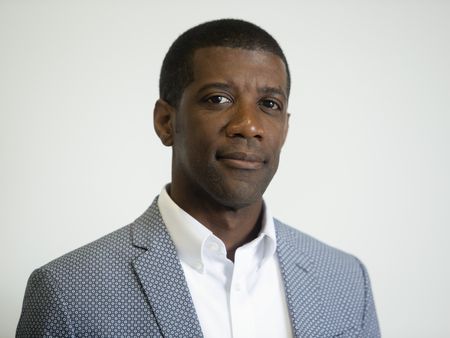 After only a year at cleveland.com, former New Orleans Times-Picayune columnist Jarvis DeBerry (pictured) told readers Friday that he is leaving. “States Newsroom, a national journalism nonprofit, offered me the opportunity to start and oversee a news outlet in Baton Rouge, La. And I couldn’t count on such an unexpected and awesome opportunity ever knocking again,” DeBerry wrote. Meanwhile, Rick Edmonds of the Florida-based Poynter Institute wrote of the recent gutting of cleveland.com’s unionized sister, the Plain Dealer. “From 1,000 miles away here at Poynter, the April culling of what remained of the Plain Dealer staff looks to be a classic exercise in union-busting,” Edmonds wrote. (Added May 1.)
After only a year at cleveland.com, former New Orleans Times-Picayune columnist Jarvis DeBerry (pictured) told readers Friday that he is leaving. “States Newsroom, a national journalism nonprofit, offered me the opportunity to start and oversee a news outlet in Baton Rouge, La. And I couldn’t count on such an unexpected and awesome opportunity ever knocking again,” DeBerry wrote. Meanwhile, Rick Edmonds of the Florida-based Poynter Institute wrote of the recent gutting of cleveland.com’s unionized sister, the Plain Dealer. “From 1,000 miles away here at Poynter, the April culling of what remained of the Plain Dealer staff looks to be a classic exercise in union-busting,” Edmonds wrote. (Added May 1.)
- “In the wake of the COVID-19 crisis that has forced colleges and universities across the nation to postpone their commencement celebrations, a coalition of HBCU leaders, advocacy organizations, and corporate partners have come together to host the National HBCU Commencement Celebration,” Essence announced on Tuesday “The virtual event, the brainchild of Paul Quinn College president Dr. Michael J. Sorrell, will be streamed live internationally on ESSENCE Studios (www.essencestudios.com) thanks to a partnership with ESSENCE. . .” The event takes place May 16.

- Citing its diversity record, “the “Accrediting Council on Education in Journalism and Mass Communications (ACEJMC) granted reaccreditation on Saturday, April 25, to the Donald W. Reynolds School of Journalism and Center for Advanced Media Studies at the University of Nevada, Reno,” the university announced Monday. “The review team also noted the Reynolds School’s ‘real efforts to address diversity and inclusion issues.’ The school was awarded the Association for Education in Journalism and Mass Communication Equity and Diversity Award in 2019. . . .”
- “Diamond and Silk have spoken out after news hit that they were fired from Fox News Channel, and they’ve done everything from trying to divert the news to blaming the move on the devil,” Royce Dunmore reported Tuesday for NewsOne. “The two media personalities were trending on social media after it was revealed that the far-right news network severed ties with them. In response, the MAGA duo tried to divert attention to the sexual assault allegations against Joe Biden. . . .”
- “Michelle Obama has announced the release of a documentary film based on experiences she encountered after writing her memoir, ‘Becoming.’ “ Kate Bennett reported Monday for CNN. ” ‘I’m excited to share that on May 6, Netflix will release BECOMING,’ Obama tweeted Monday. . . .”
- Instruction for the Sports Journalism Institute’s annual “boot camp” will take place online, via Zoom, because of ongoing issues surrounding the coronavirus, the institute announced Monday. “Boot camp will run the week of June 1 and we are again working with our partners at Arizona State University,” the announcement said. David Squires, Malcolm Moran, Michael Wilbon, Paola Boivin, Richard Deitsch Dr. Scott Brooks, Malika Andrews and Cam Wolfe will be among the instructors for the class of 16. The institute aims to enhance racial and gender diversity in sports media.
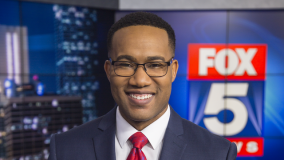 “NBC4 (WCMH-TV) announces Kerry Charles (pictured) will become NBC4’s new 6pm, 7pm and 11pm news anchor,” WCMH-TV in Columbus, Ohio, announced April 20. “Starting June 15, Kerry will co-anchor NBC4’s evening and late news with Colleen Marshall. Kerry is returning home to Columbus. . . .” Charles most recently worked as an anchor and reporter at Atlanta’s WAGA-TV, known as Fox 5.
“NBC4 (WCMH-TV) announces Kerry Charles (pictured) will become NBC4’s new 6pm, 7pm and 11pm news anchor,” WCMH-TV in Columbus, Ohio, announced April 20. “Starting June 15, Kerry will co-anchor NBC4’s evening and late news with Colleen Marshall. Kerry is returning home to Columbus. . . .” Charles most recently worked as an anchor and reporter at Atlanta’s WAGA-TV, known as Fox 5.
- “World Channel is boosting its presence on YouTube and aiming to reach wider audiences by adding more exclusive and original content to its online offerings,” Grace Vitaglione reported Monday for Current. “The broadcast channel and multimedia content producer, which is operated by WGBH in Boston and distributed by American Public Television, launched the initiative March 31 with the release of Two Dollars and a Dream, directed by Stanley Nelson. . . . Two Dollars and a Dream examines the life and journey of America’s first self-made female millionaire, Madam C.J. Walker.
- “TMZ has continually faced scrutiny for taking things too far when reporting Black death, including posting graphic photos before the news of the deceased has even had time to settle with family members,” Royce Dunmore reported April 13 for NewsOne. “By Monday morning, it was revealed that former Minnesota Vikings and Seattle Seahawks quarterback Tarvaris Jackson died in a car crash at 36 years old and already, TMZ published graphic photos of the crash. . . .”
- “Namibia continues to be ranked the country with the freest media environment in Africa, according to the latest 2020 Press Freedom Index issued by Reporters Without Borders,” Maria Amakali reported April 22 for New Era in Namibia.
- Reporters Without Borders said Saturday it “condemns a series of disproportionate sanctions on Tanzanian media outlets and journalists in connection with their coronavirus coverage and urges the authorities not to reinforce the climate of harassment and fear in Tanzania, where press freedom has declined steadily since 2016. . . .”
- On April 1, in Sierra Leone’s eastern Kenema city, a group of at least 10 soldiers attacked Fayia Amara Fayia, a reporter with the Standard Times newspaper, the Committee to Protect Journalists reported Tuesday. The soldiers hit him with their guns and kicked him, according to the journalist, who spoke to CPJ in a phone interview, and a statement by the Sierra Leone Association of Journalists, a local press freedom group. “Fayia told CPJ that the soldiers attacked him and seized his phone after he photographed a new COVID-19 quarantine center. The soldiers then arrested him and alleged that he had assaulted a soldier and District Head Mohammed O. Level Sesay, a local official who was at the scene, Fayia said. . . .”
- The Committee to Protect Journalists joined 16 other civil society groups Tuesday “in sending a letter to Mozambican President Filipe Jacinto Nyusi expressing concern about the deteriorating human rights situation in northern Cabo Delgado province, including the enforced disappearance of radio journalist Ibraimo Abú Mbaruco,” CPJ said.
- In Sri Lanka, Mahinda Rajapaksa and his brother Gotabaya Rajapaska, who have returned to power after five years, are credited for ending the civil war with Tamil separatists, but they are also accused of brutal human rights violations, including extrajudicial killings and abductions of journalists, Aliya Iftikhar reported Tuesday for the Committee to Protect Journalists. Iftikhar also wrote, “Arumugam Sabeswaran, a sub-editor for the Tamil daily newspaper Thinakkural, told me . . . that reporting had already visibly changed in the past three months, with fewer details being included in articles. . . . ‘The people who killed the journalists, they’re living with us,’ said Sabeswaran. ‘We have fear they can still kill. We can’t enjoy freedom of press.’ . . .”
Facebook users: “Like” “Richard Prince’s Journal-isms” on Facebook.
Follow Richard Prince on Twitter @princeeditor
Richard Prince’s Journal-isms originates from Washington. It began in print before most of us knew what the internet was, and it would like to be referred to as a “column.” Any views expressed in the column are those of the person or organization quoted and not those of any other entity. Send tips, comments and concerns to Richard Prince at journal-isms-owner@yahoogroups.com
View previous columns (after Feb. 13, 2016).
- Diversity’s Greatest Hits, 2018 (Jan. 4, 2019)
- Book Notes: Is Taking a Knee Really All That? (Dec. 20, 2018)
- Book Notes: Challenging ’45’ and Proudly Telling the Story (Dec. 18, 2018)
- Book Notes: Get Down With the Legends! (Dec. 11, 2018)
- Journalist Richard Prince w/Joe Madison (Sirius XM, April 18, 2018) (podcast)
- Richard Prince (journalist) (Wikipedia entry)
- February 2018 Podcast: Richard “Dick” Prince on the need for newsroom diversity (Gabriel Greschler, Student Press Law Center, Feb. 26, 2018)
- Diversity’s Greatest Hits, 2017 — Where Will They Take Us in the Year Ahead?
- Book Notes: Best Sellers, Uncovered Treasures, Overlooked History (Dec. 19, 2017)
- An advocate for diversity in the media is still pressing for representation, (Courtland Milloy, Washington Post, Nov. 28, 2017)
- Morgan Global Journalism Review: Journal-isms Journeys On (Aug. 31, 2017)
- Diversity’s Greatest Hits, 2016
- Book Notes: 16 Writers Dish About ‘Chelle,’ the First Lady
- Book Notes: From Coretta to Barack, and in Search of the Godfather
- Journal-isms’ Richard Prince Wants Your Ideas (FishbowlDC, Feb. 26, 2016)
- “JOURNAL-ISMS” IS LATEST TO BEAR BRUNT OF INDUSTRY’S ECONOMIC WOES (Feb. 19, 2016)
- Richard Prince with Charlayne Hunter-Gault,“PBS NewsHour,” “What stagnant diversity means for America’s newsrooms” (Dec. 15, 2015)
- Book Notes: Journalists Follow Their Passions
- Book Notes: Journalists Who Rocked Their World
- Book Notes: Hands Up! Read This!
- Book Notes: New Cosby Bio Looks Like a Best-Seller
- Journo-diversity advocate turns attention to Ezra Klein project (Erik Wemple, Washington Post, March 5, 2014)
